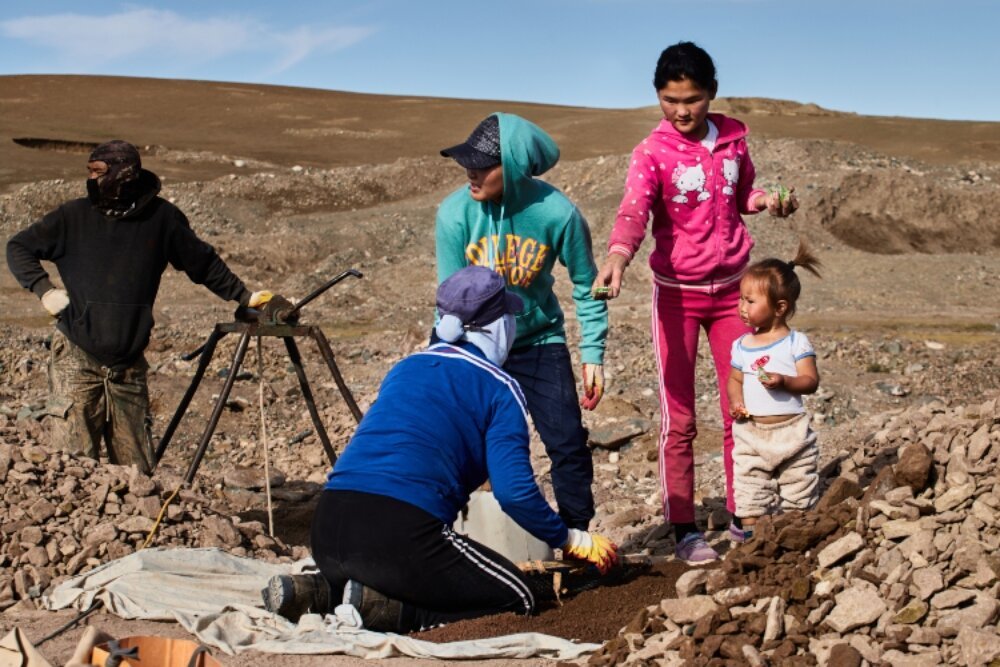Ethical Mining - A review of The Shadow of Gold
Are you curious about environmental issues surrounding the gold industry? Have you heard of conflict gold and want to know more? You *need* to see the documentary The Shadow of Gold.
Shadow of Gold is a film, by Denis Delestrac, Robert Lang and Sally Blake, along with 6 other directors and cinematographers from around the world: China, Peru, Canada, the U.S., London, Dubai, and the Democratic Republic of Congo. Local people were needed to film and direct parts of the documentary because a foreigner in some of those situations would have a very hard time.
The documentary traces ethical shortcomings in the gold industry.
An entire Mongolian family working at artisanal mining
Several case studies are followed, each focusing on a different ethical struggle of the industry.
Canada, the Mt Polley disaster, the contamination of the water in the Cariboo region of central British Columbia.ii On August 4th, 2014, a tailings pond, the size of 10 000 Olympic-sized swimming pools full of toxic copper and gold mining waste breached, spilling nickel, arsenic, lead, and copper into the local waterways. 溺ine safety experts and media articles have called the spill one of the biggest environmental disasters in modern Canadian history.iii
Peru, where artisanal miners in bare feet without masks or gloves use primitive blowtorches to heat up mercury in order to extract gold from the rocks they collect. These miners know that what they’re doing is personally and environmentally dangerous, but it is their only option to feed their families.
China, where a small scale dry mining has resulted in Silicosis of the miners’ lungs. The treatment for it is 1000 Yuan/month, compared to the 300 Yuan/month of the miners’ salaries. These miners are waiting to die. While they are, they are lobbying the Chinese government for compensation, unsuccessfully so far.
The Democratic Republic of Congo, where small scale artisanal miners are watched over by the gun toting “soldiers” (armed groups, from both government forces or rebel militia). The money from the gold is used to pay for the civil wars in the region. iv
Dubai, where the largest gold refineries in the world are located; home to Kaloti, the biggest of said refineries. There are “international efforts...to stamp out the illicit trade in conflict gold by requiring the world's largest refineries to be independently audited to check that they are sourcing gold responsibly and publishing the findings.v Amjad Rihan, an accountant formerly of the accounting firm, Ernst and Young, followed the trail of gold from the gold refinery, Kaloti, to where it was mined. He discovered a tremendous amount of untoward activities such as money laundering and evidence that some of the gold that passes through the refinery is conflict gold. Since his report, Rhian has been dismissed from Ernst and Young for refusing to return to Dubai where he feared for his and his family’s safety.
Stacks of goldbars in Dubai
But the film reports it's not all bad news;
Nobel Laureate (2016) Sir Fraser Stoddart has discovered a way of refining gold that doesn’t use cyanide or mercury. He won the Nobel Prize for his discovery that you can extract gold using a process involving hydrogen peroxide and cornstarch. His start up, “Cycladex”, is presently testing the process with the Comstock goldmine in Nevada.
A Canadian NGO called IMPACTvi, works in the Democratic Republic of Congo on creating systems that encourage the traceability of conflict-free gold. In addition, they are creating mechanisms to help Congolese women to become artisanal miners and extract gold in a local small scale level; circumventing the production of conflict gold.
Finally, a jewellery company in Toronto, the Fair Trade Jewellery Co., is using ethically sourced gold. They purchase gold with documentation proving the provenance of every ingot they buy. There is a direct supply chain that traces the gold from the miners all the way to the jeweller's bench.
The multiple case studies presented in this documentary highlight the many issues surrounding the mining of gold around the world today. From ecological disasters, to the deaths of miners, to gold mining that props up war, the world of gold is complex. Jewellers need to start becoming aware of where their raw materials come from. In an increasingly “issues-saavy” world more and more people are starting to ask where the raw materials of their jewellery comes from, to make sure their jewellery does not come from ecologically or socially questionable origins.
i https://theshadowofgold.com/
ii https://www.cbc.ca/news/canada/british-columbia/mount-polley-anniversary-1.3706850
iii https://www.amsj.com.au/breach-tailings-pond-results-largest-environmental-disaster-modern-canadian-history/
iv https://www.dw.com/en/democratic-republic-of-congo-army-general-profits-from-illegally-mining-conflict-gold/a-40325398
v http://ipisresearch.be/publication/analysis-interactive-map-artisanal-mining-areas-eastern-dr-congo-2/
vi https://impacttransform.org/en/countries/democratic-republic-of-congo/


